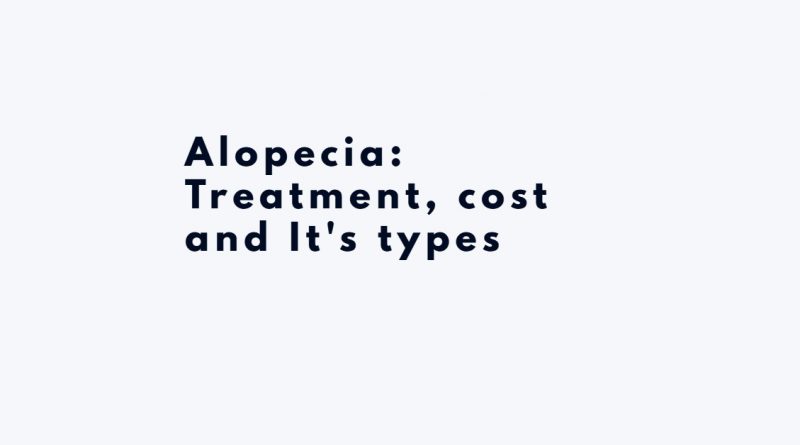Alopecia: Treatment, cost and It’s types
suffering from alopecia? Are you considering diagnosis and possible treatments? Are you worried about cost? Here are8 facts that will be useful as you start this journey.
ALOPECIA: TREATMENT, COST, AND ITS TYPES
Baldness and alopecia are the same. It is characterized by the loss of hair in patches on the scalp. These patches may sometimes overlie. This makes the alopecia more noticeable. As much as hair loss is associated with the scalp, it can affect any part of the body. For example eyebrows and lashes.
Some of the causes of baldness include diet, age, medication, hormonal imbalance, and traumas. Signs of the onslaught of alopecia include thinning hair or clumps of hair in the pillow and while washing. Alopecia affects both men and women but is much more prevalent in men.
Types of Alopecia
The main types of alopecia include:
· Alopecia areata
This type of baldness is associated with the immune system. The immune system assaults the hair grades which causes them to fall off. Although hair will grow back, if the attacks on the follicles continue, the hairs will continue to fall off. Some factors greatly contribute to who is affected by alopecia. Family history, conditions such as asthma, and certain cancer medication.
Alopecia areata
Source: Wikimedia
· Androgenic alopecia
This type of alopecia is also known as female or male pattern alopecia. It starts from the hairline in men and women, hair thinning is prevalent. Rarely, men develop bald spots but maintain the hairline. Some women may also experience bald spots but not total loss of hair. In both cases, it takes time to see the full effect of the condition. Some cases take decades. The causes can be attributed to genetic makeup or prevailing environmental conditions.
· Traction alopecia
Traction alopecia is a form of baldness caused by tension on the scalp and hair follicles. Relaxed hair and hairstyles that exert too much tension on the scalp are usually the culprits. Some people, especially children, suffer from a condition called trichotillomania. This condition causes the impulse to pull on hair no matter where it is on the body.
Traction alopecia
Source: Wikipedia
· Toxic alopecia
This type of hair loss is caused by a certain type of illness or medication. Vitamin A, for example, can cause alopecia if taken over a long period in high doses. Cancer medication has also been proven to cause hair loss. Fortunately, toxic alopecia is not permanent. As soon exposure to such elements is stopped, hair growth will resume.
· Cicatricialalopecia
Cicatricialalopecia also known as scarring alopecia, is a form of hair loss caused by scars. Scarring on skin tissue also causes damage to the hair follicles. This makes it impossible for hair to grow. It can be caused by several health conditions such as lupus or external conditions like relaxing hair and extreme heat. Its symptoms include redness in the affected area, itchiness, and skin marks. It affects both men and women. Age is not a factor.
Scarring alopecia
Source: Wikimedia
Treatment of Alopecia
There is no blanket treatment when it comes to alopecia. As discussed, there are several types of alopecia. It all depends on what type needs to be treated. Some of these hair loss conditions don’t need any form of treatment. They just clear out over time. Some are related to the medication taken. A substitute may be provided if a health practitioner approves.
In cases in which treatment is available and necessary, there are two best options.
· Surgery
Surgery is the most efficient way for hair restoration. The success rate is the highest compared to medication. Hair transplant surgery involves the extraction of hair grafts from a healthy part of the scalp or body. These grafts are then transplanted to the balding area. The most common types of surgery are Follicular Unit Extraction(FUE) and Follicular Unit Transplant.
· Medication
Under medication treatment, there are various methods. Consistency is the key to the medical treatment of alopecia. Missing a dose could be detrimental to the success of the therapy.
· Using hormones such as estrogen can help the healthy growth of hair. Estrogen sustains the life of a strand for longer periods. It achieves this effect by prolonging the growth stage of hair.
· Minoxidil is another drug that can be used to stimulate hair growth. It was originally meant for the treatment of high blood pressure. Applied, it stimulates new hair growth especially at the onset of alopecia.
· Corticosteroids are immunologic drugs that suppress immune action against hair follicles. It is best in treating alopecia areata and other hair loss caused by the immune system.
Cost Of Treatment
The cost of treating alopecia varies depending on the type of alopecia. In a case where the hair loss is caused by medication taken for an existing condition, changing medication is advised. This will coat close to nothing. Furthermore, alopecia can be treated with Over The Counter (OTC) medication.
However, some medications are costly. A good example is the steroid Corticosteroids. It can be applied via injection, topically, or orally. Some pay upwards of $140 per injection. The most expensive, though, is a hair transplant which can cost $3500 and above. The advantage, in this case, is the permanence of the treatment. Most hair transplant surgeries have a higher success rate.
Conclusion
It is important to know that most types of alopecia disappear on their own. No treatment is required. Nonetheless, some cases have no known cure. A visit to a qualified doctor will give more insight on which course to take. The only way to overcome alopecia is to not stay quiet. Speak out and find a solution.



